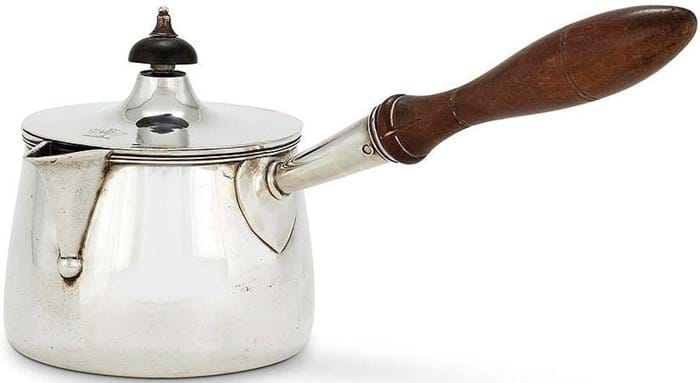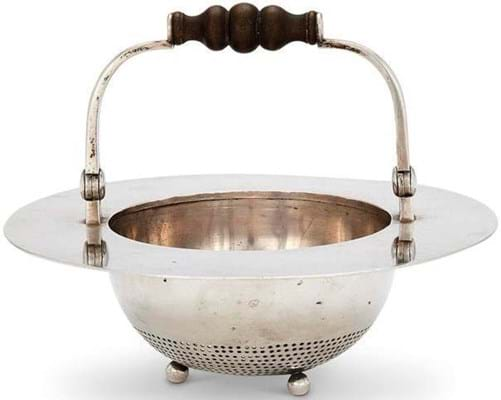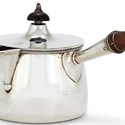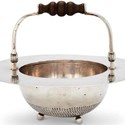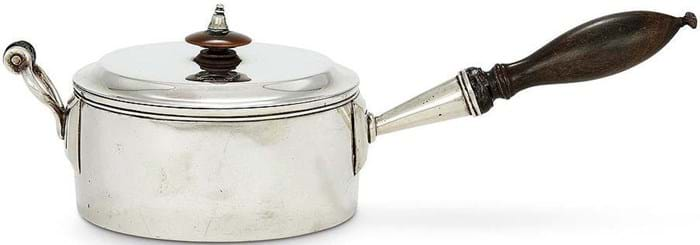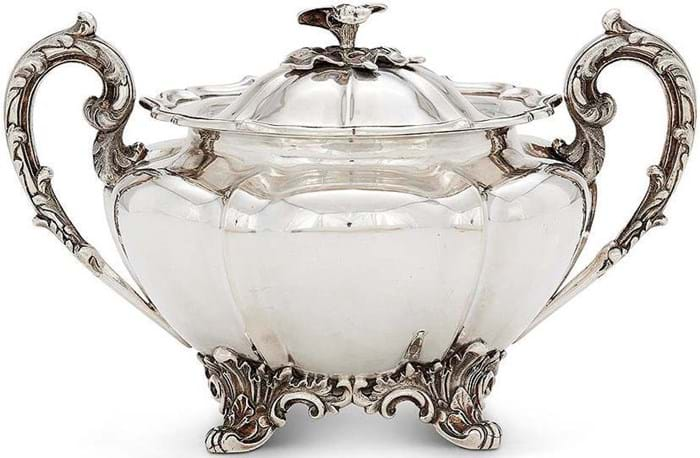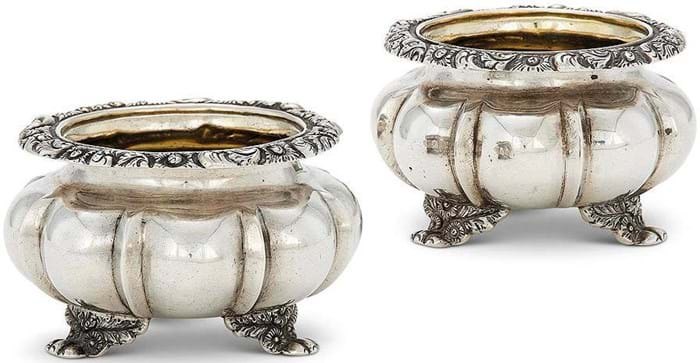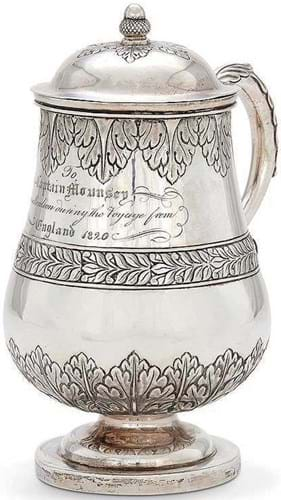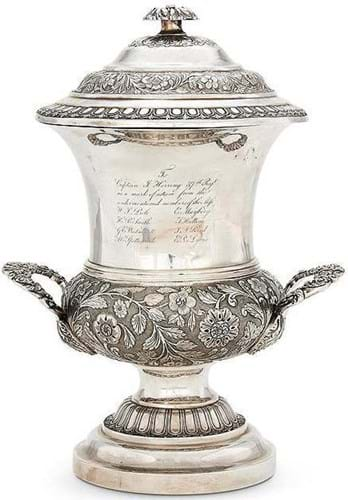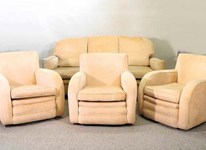Unlike the later ‘kutch’ silver that was made by Indian craftsmen often for export to the West, Anglo-Indian silver was typically made by English and Scottish silversmiths who relocated to the subcontinent.
In search of fortune and adventure in the days of the Raj, they set up workshops and shops in the major cities of Calcutta, Madras and Bombay.
Many of the forms they created mirrored those that were popular in Britain at the time, although some were new or adapted for life in the subcontinent.
These include milk and butter coolers that countered against the intense heat, covered vessels which kept flies at bay, saucepans for curry and sterilising liquids and the ‘campaign’ forms that could be easily carried by attendants during travel.
Most pieces carried the simple maker’s marks (typically only initials, letters and symbols) that – before the publication of Indian Colonial Silver by dealer Wynyard Wilkinson in the 1973 – were often erroneously thought to be Scottish or Irish.
Catalogue expertise
A large collection of Anglo-Indian pieces was offered for sale in 43 lots at Dreweatts (25% buyer’s premium) in Donnington Priory, Newbury, on July 7.
Wilkinson provided the catalogue introduction, singling out some of his favourite pieces.
He explains that silver curry pans could be brought to the table using the long wood or horn handle and then converted into a passable entrée dish by substituting a shorter handle. The form was “a true hybrid specific to the requirements of the Raj”.
Survivors with all three detachable handles are rare, making an example by John Hunt c.1810 particularly desirable.
The crest and motto belong to John Stuart (1751-1827) the 8th Laird of Inchbreck House near Glenbervie. A lawyer, preacher and professor of Greek at Marischal College in Aberdeen, in 1810 he married Margaret Mowat, daughter of an Aberdeen merchant.
Estimated at £400-600, the pan made £700 from an internet bidder.
Butter coolers would have been filled with a mixture of saltpeter and water to keep the contents from melting.
A good example retaining its original liner by the Lattey Brothers of Calcutta, c.1835, it was made in the fashion of the day with twin foliate scroll handles, four foliate scroll feet and a flower finial to the lobed domed cover. Measuring a substantial 9½in (24cm) across and weighing 44oz, it would, said Wilkinson, work well today as a caviar dish. It took £1200.
Colonial silver open salts are uncommon, as customers much preferred covered and more portable examples. A pair here of cauldron form with chased foliate borders and lion paw feet made by the Bombay partnership of Mathies & Barron, c.1830, sold online at £800.
Hierarchy of makers
Wilkinson researched more 900 Europeans who worked in the goldsmith, silversmith, jewellery trades in India and has been able to establish a clear hierarchy of makers.
Among the most talented was Patrick Moran, whose work often echoes the late Regency style.
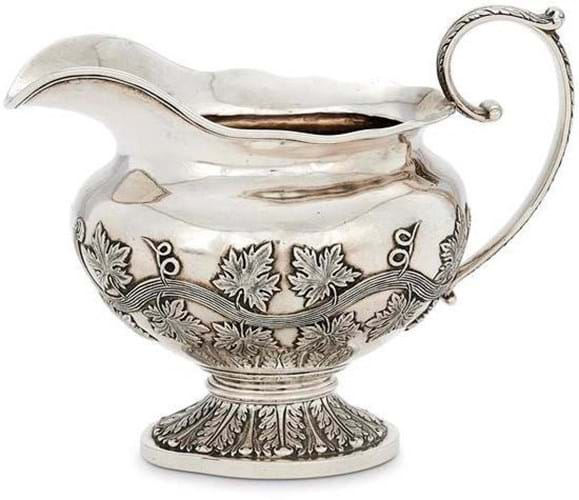
Milk jug by Patrick Moran c.1830 – £1600 at Dreweatts.
A weighty 19oz milk jug worked with a frieze of vine leaves, c.1830, was a particularly good example. Wilkinson commented: “You have to hold this jug in your hands to appreciate the brilliance of the silversmithing skills that have gone into making it. Bold, tactile, and remarkably large by a very rare maker. A lovely piece of silver.”
The market concurred and it sold at £1600 (estimate £300-500).
John Mair trained in Aberdeen before setting off to make his fortune in Calcutta, later retiring back to a genteel life in London.
He was the maker of an early version of the saucepans most commonly used to boil milk, dating from c.1800, with the crest of the Johnson family of Stamford, Lincolnshire, which took £380.
Stories of empire
Many pieces came with stories of empire. An 8in (21cm) high baluster mug and cover by Hamilton & Co sold at £1200 was engraved To Captain Mounsey for his attention during the voyage from England 1820.
Mounsey had a distinguished naval career that had began 40 years earlier at the tender age of 13. During service he captured 31 of the enemy’s ships including the frigate La Furieuse, for which he received the thanks of the admiralty and later was nominated for the Order of the Bath in June 1815.
Gifts between soldiers were quite commonplace in 19th century India. A good example with a poignant story was a trophy cup and cover made by Twentyman & Co in Calcutta, c.1835.
Standing 13½in (34cm) high, it is chased with a floral band and engraved To Captain J Herring 37th Regiment as a mark of esteem from the undermentioned member of the Mess. Herring had arrived in India in 1805. He rose to the rank of lieutenant during the Nepal War in 1814-15 and lieutenant-colonel when his military adventures in the 37th Regiment of the Bengal Native Infantry took him to Afghanistan.
During the First Afghan War he was killed by tribesmen at Haidar Khel in December 1839 and was buried in Kabul two days later.
The 54oz trophy sold for £1000, the lower end of expectations.


